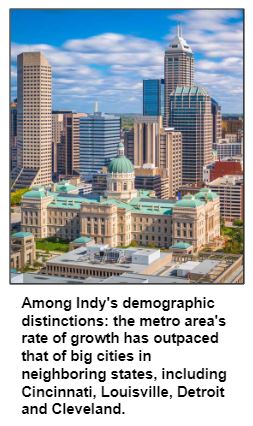May 16, 2020
With the U.S. Census underway, Hoosier History Live is turning to a respected demographer to shine a light on trends - some recent and others deeply historic - about the state's residents and where they live.

Some other intriguing statistics: In 1860 - the year before the Civil War - Indiana was the fifth most populous state in the country, "trailing New York, Pennsylvania, Ohio and Illinois," Matt says.
And, although 60 of Indiana's 92 counties gained people in 2018, some counties experienced population declines. In fact, several rural counties peaked in population during the early 1900s and have been losing residents ever since. Other counties with mid-sized cities that served as manufacturing hubs peaked during the 1960s and '70s.
Matt will be Nelson's guest to discuss population and demographic shifts, including the state's increasing diversity. From 2010 to 2013, the Hispanic population showed the largest growth of any racial or ethnic group, increasing by about 10,000 residents each year. More recently, though, the birth rate among Hispanic families has fallen sharply and, as Matt describes it, "is more in line with other groups in the state."
During the early 1990s, Hoosier teenagers were nearly as likely to give birth as women ages 30 to 34, according to Matt's research. By 2017, though, the birth rate for teenagers had fallen below that for women in their early 30s. He notes that both state and national birth rates have been declining since 2007, tracking the onset of the recession that began in 2008.

- In 2018, the Indianapolis metropolitan area had 2.04 million people, or about 31 percent of the state's total population. The fastest-growing county in the state was Hamilton County, followed by Hendricks County.
- Union County in far-eastern Indiana (the county seat is the town of Liberty) experienced the sharpest rate of population decline in 2018, while Delaware County (which includes Muncie) lost the largest number of residents.
- In 1900, 66 percent of the state's population lived in rural areas. Just 19 percent did in 2010.
Primarily rural counties that peaked in population in 1920 or earlier include several in western and southern Indiana. Benton County, Warren County, Vermillion County, Greene County, Crawford County and Pike County are among them.
Counties with manufacturing hubs that peaked in population during the 1960s and '70s - and have been declining since - include Howard County (where Kokomo is thelargest city), Madison County (which includes Anderson) and Wayne County (where Richmond is the county seat).
The population growth rate in the Indianapolis metro area outpaced those of neighboring states' metro areas including Cincinnati, Louisville, Detroit and Cleveland, according to Matt's analysis. But Columbus, Ohio, had a growth rate that exceeded Indy's.
The white (non-Hispanic) share of Indiana's population dropped from 86 percent in 2000 to 80.7 percent in 2013, Matt reports. During that same period, the statewide percentage of African-Americans increased from 8.4 to 9.2 percent, with Hispanics climbing from 3.5 to 6.4 percent. "Much of the diversity is occurring among young people," Matt adds.
After the 2010 U.S. Census, Matt Kinghorn was a guest on Hoosier History Live for a show analyzing its findings. For more Indiana-specific info for various decades and demographic research, visit these sites: